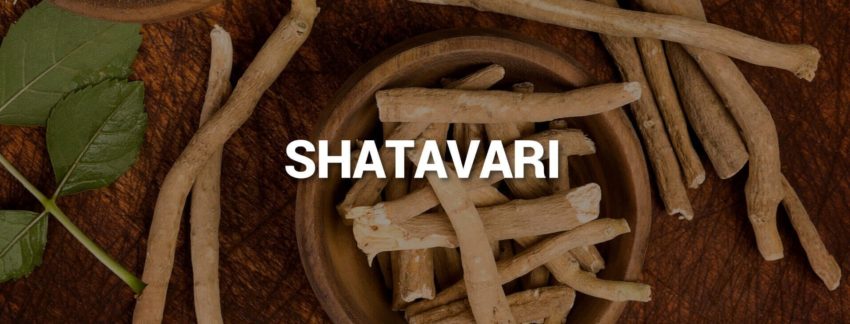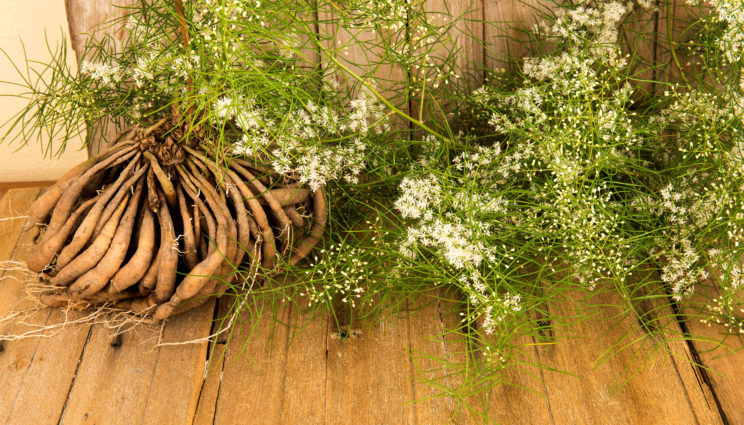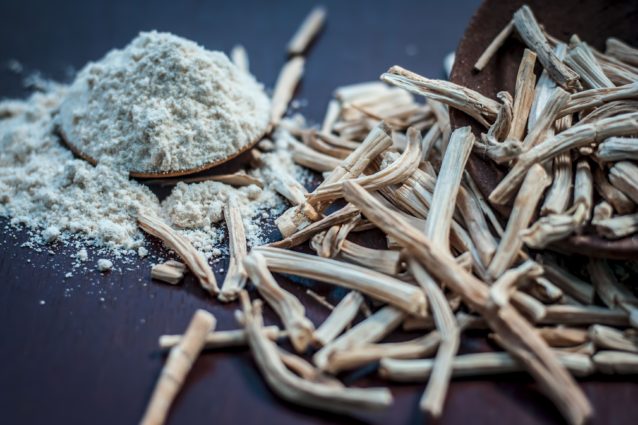
Shatavari powder (Asparagus Racemosus)
Shatavari, asparagus seed, asparagus racemosus (Latin), Indian asparagus, one hundred roots, asparagus roots (English), satavar, satavari, shatamull (Indian)
Shatavari is the main Ayurvedic anti-aging plant for women — the same as Ashwagandha (Ashwagandha powder) for men (although both plants have some effect on both sexes).
It serves as a rejuvenating agent for Pitta, for the female reproductive system. For this purpose, Shatavari is prepared in the form of a milk broth with the addition of ghee oil, unrefined sugar, honey, and pippali.
Shatavari has a softening effect on the stomach, lungs, kidneys, and genitals’ mucous membranes and is effective for stomach ulcers.
Shatavari relieves thirst, promotes the preservation of fluids in the body, is indicated for diarrhea and dysentery.
Applied externally, Shatavari has a significant softening effect on joint and neck stiffness, as well as muscle spasms.
Soothes and softens Vata Dosha.
Shatavari increases the secretion of milk and semen nourishes the mucous membranes. At the same time, it nourishes and cleanses the blood and female genitals.
Shatavari is good for women in menopause or who have undergone surgery to remove the uterus because it contains a lot of female sex hormones.
Shatavari nourishes the eggs and increases their ability to fertilize; in addition, it has a Sattvic Nature, promotes the development of love and devotion.
Shatavari increases Ojas (vital energy) in a weakened body and is very effective for anemia, as well as for cleansing the liver and blood, and for the treatment of genital herpes Vata — type, accompanied by dry skin, constipation, loss of strength, and insomnia; ulcers are painful and hard, but redness and other signs of inflammation are not observed.
Shatavari has excellent nourishing and emollient properties and calms the heart. Shatavari is also very effective for persistent, prolonged fevers.
Shatavari is extremely rich in steroid saponins, which have a hormone-like effect.
Shatavari rejuvenates the female sexual system.
Shatavari increases the production of breast milk normalizes the monthly cycle, increases the ability of eggs to fertilize.
Shatavari prevents the occurrence of fibromyomas and mastopathy. Shatavari prevents the accumulation of dihydrotestosterone, which in older men causes the growth of the prostate gland. The alkaloid asparagine was found in Shatavari, increasing cardiac output and reducing heart rate and blood pressure. In addition, the Shatavari plant is rich in bioflavonoids, which prevent damage to cell membranes.
Application:
The basic course in the morning and the evening, 1/4-1 teaspoon on an empty stomach – 30 minutes before meals for 3-4 months. It is recommended to drink with a milk (warm) as a tonic. Warm water or tea made from fresh ginger-to induce menstruation, aloe juice – for the type of Pita.
Additional information:
Shatavari is a creeping plant, up to two meters tall, which grows everywhere in India and the Himalayas and prefers mountainous and rocky terrain. In addition to India, it grows in South Asia, Australia, and parts of Africa.
It has small shiny dark green leaves that resemble coniferous needles, white flowers, and black and purple berries.
Shatavari has a very developed root system, extending up to one meter from the plant. Each plant has about a hundred roots, hence the Sanskrit name Shatamuli (Shata-hundred, muli-roots). The roots contain a large amount of mucus.
Shatavari roots are used in Ayurveda after they are processed and dried. The bark and berries of Shatavari are poisonous due to the high content of alkaloids in them.
Shatavari is one of the world’s most famous adaptogenic plants.
Adaptogens are plants that increase the body’s resistance to stress, injury, fatigue, anxiety, and anxiety, thanks to the saponins they contain. They are called anti-aging herbs, natural tonics, in Ayurveda, they are called Rasayanas (general strengthening and rejuvenating elixirs). Adaptogenic herbs can balance the hormonal and immune systems and restore the body and its basic functions after stress. All adaptogens contain antioxidants.
Shatavari has been used in Ayurvedic and Tibetan medicine since ancient times. It affects all the tissues of the body, stimulates the digestive, respiratory, cardiovascular, and reproductive systems. In medicine, the leaves and, mainly, the roots of the plant are used.
Shatavari contains proteins, alkaloids, saponins, tannins, bioflavonoids, vitamin B, calcium, and zinc. The alkaloid Shatavari I-V supports the body’s natural production of estrogen.
In Ayurveda, Shatavari is an extremely important plant and the main tonic for the entire female body, although it is also successfully used for men. Shatavari is translated as “having a hundred husbands” because it has such a tonic effect on the female genitals that the woman becomes able to satisfy a hundred lovers.
Shatavari has antioxidant, antibacterial, antiseptic, anti-inflammatory, diuretic, emollient, astringent, antispasmodic properties.

The medicinal properties of Shatavari are used in the following cases:
– as a strong aphrodisiac, increases sexual energy and desire, treats frigidity in women, increases libido
According to the ancient Indian tradition, Shatavari promotes the development of love and devotion.
– as a remedy for infertility, activates the eggs and increases their ability to fertilize
– for pain and cramps during menstruation due to its anti-spasmodic and soothing properties, Shatavari normalizes the monthly cycle
– to balance the female hormonal system and prevent the development of many female diseases and the growth of tumors
– after surgery to remove the uterus and during menopause, because it contains a large number of natural analogs of female sex hormones
– to prevent miscarriage
– in the treatment of impotence and inflammation of the male genitals
– as an antiseptic, cleanses the mucous membranes of the female genital tract
– with vaginal dryness
— to increase the secretion of breast milk secretion
– as a diuretic, antibacterial and emollient, helps with cystitis and urolithiasis
– as an antibacterial agent, cleanses the blood
– as an anti-inflammatory agent, Shatavari is also used for colds and long and prolonged fevers
– as an emollient for the mucous membranes of the lungs, kidneys, and genitals
– in the treatment of gastritis and gastric ulcer
– for healing ulcers and wounds, as an astringent
– in the treatment of diarrhea and dysentery, as it relieves thirst and retains fluid in the body
– with muscle spasms, with the stiffness of the neck and joints
– as a tonic for the body and nervous system, gives vital energy to a weakened body, treats epilepsy and hysteria
– to normalize the water-lipid balance of the body
– with anemia
– for herpes, including genital herpes
– as an antiseptic, it treats many skin diseases
– helps with bleeding, as an astringent
– as a remedy with excellent nutritional properties
– as a means of softening and soothing the heart, reduces the heart rate
– to lower blood pressure, increase hemoglobin
– with high acidity
– to improve vision, increases visual acuity
– for hemorrhoids
– to protect the liver
Shatavari is used in the form of powder, paste, oils, or decoction and is often drunk with warm milk or warm water, where unrefined sugar, honey, or ghee can be added. In combination with ginger tea, Shatavari provokes menstruation and is taken for menstrual delays. For the convenience of reception, it is made in capsules.
Shatavari is the basis for two famous Ayurvedic powders — Shatavari Kalpa and Shatavari Churna. Shatavari Kalpa is a supplement for women, Shatavari Churna is a multi-component supplement for men.
In addition to ingestion, Shatavari is used in cosmetology and is an important component of many Ayurvedic beauty formulas. Shatavari is included in various cosmetics-face and body creams, tonics, milk, lotions, oils, masks, hair products primarily as a strong antioxidant that slows down skin aging as a blood purifier. Shatavari is suitable for all skin and hair types.
Shatavari is used in cosmetology thanks to
– antioxidant and anti-aging properties
Shatavari tones and rejuvenates the skin saturates it with oxygen improves the complexion.
It is used in anti-aging cosmetics.
– nourishing and emollient properties
Shatavari nourishes and smoothes the skin, makes it soft and smooth, relieves irritation and stress, soothes inflamed skin.
– astringent, wound-healing properties
Thanks to the natural viscosity of Shatavari, it heals and tightens ulcers and wounds.
– anti-edematous properties
Thanks to its ability to retain fluid, Shatavari maintains the water balance of the skin, retains the necessary moisture, and eliminates puffiness.
– antiseptic and antibacterial properties
Shatavari treats skin diseases, particularly skin infections.
In India, Shatavari roots, boiled in oil, have long been used to treat skin diseases.

Shatavari powder (Asparagus Racemosus)
The material is prepared by specialists for informational purposes only. It should not be used as a guide for the treatment of diseases, and it cannot replace professional medical advice, diagnosis, or treatment. In case of illness or any symptoms, you should not self-medicate and should always consult a doctor.


